Alexander Haig
Alexander Meigs Haig Jr. (/heɪɡ/; December 2, 1924 – February 20, 2010) was the United States Secretary of State under President Ronald Reagan and the White House chief of staff under presidents Richard Nixon and Gerald Ford.[1] Prior to these cabinet-level positions, he retired as a general from the United States Army, having been Supreme Allied Commander Europe after serving as the vice chief of staff of the Army.
Born in Bala Cynwyd, Pennsylvania, Haig served in the Korean War after graduating from the United States Military Academy. In the Korean War, he served as an aide to General Alonzo Patrick Fox and General Edward Almond. After the war, he served as an aide to Secretary of Defense Robert McNamara. During the Vietnam War, Haig commanded a battalion and later a brigade of the 1st Infantry Division. For his service, Haig was a recipient of the Distinguished Service Cross, the Silver Star with oak leaf cluster, and the Purple Heart.[2]
In 1969 Haig became an assistant to National Security Adviser Henry Kissinger. He became vice chief of staff of the Army, the second-highest-ranking position in the Army, in 1972. After the 1973 resignation of H. R. Haldeman, Haig became President Nixon's chief of staff. Serving in the wake of the Watergate scandal, he became especially influential in the final months of Nixon's tenure, and played a role in persuading Nixon to resign in August 1974. Haig continued to serve as chief of staff for the first month of President Ford's tenure. From 1974 to 1979, Haig served as Supreme Allied Commander Europe, commanding all NATO forces in Europe. He retired from the Army in 1979 and pursued a career in business.
After Reagan won the 1980 presidential election, he nominated Haig to be his secretary of state. After the attempted assassination of Ronald Reagan, Haig asserted "I am in control here," allegedly suggesting (erroneously since 1947, when the Speaker of the House of Representatives was designated the second in the line of succession after the Vice President) that he served as acting president in Reagan's and Bush's absence, later iterating that he meant that he was functionally in control of the government. During the Falklands War, Haig sought to broker peace between the United Kingdom and Argentina. He resigned from Reagan's cabinet in July 1982. After leaving office, he unsuccessfully sought the presidential nomination in the 1988 Republican primaries. He also served as the head of a consulting firm and hosted the television program World Business Review.
Early life and education
Haig was born in Bala Cynwyd, Pennsylvania, the middle of three children of Alexander Meigs Haig Sr., a Republican lawyer of Scottish descent, and his wife, Regina Anne (née Murphy).[3] When Haig was 9, his father, aged 41, died of cancer. His Irish American mother raised her children in the Catholic faith.[4] Haig initially attended Saint Joseph's Preparatory School in Philadelphia, Pennsylvania, on scholarship; when it was withdrawn due to poor academic performance, he transferred to Lower Merion High School in Ardmore, Pennsylvania, from which he graduated in 1942.
Initially unable to secure his desired appointment to the United States Military Academy (with one teacher opining that "Al is definitely not West Point material"), Haig studied at the University of Notre Dame (where he reportedly earned a "string of A's" in an "intellectual awakening")[5] for two years before securing a congressional appointment to the Academy in 1944 at the behest of his uncle, who served as the Philadelphia municipal government's director of public works.[5]
Enrolled in an accelerated wartime curriculum that deemphasized the humanities and social sciences, Haig graduated in the bottom third of his class[6] (ranked 214 of 310) in 1947.[7] Although a West Point superintendent characterized Haig as "the last man in his class anyone expected to become the first general,"[8] other classmates acknowledged his "strong convictions and even stronger ambitions."[7] Haig later earned an M.B.A. from the Columbia Business School in 1955 and an M.A. in international relations from Georgetown University in 1961. His thesis for the latter degree examined the role of military officers in making national policy.
Early military career
Korean War
As a young officer, Haig served as an aide to Lieutenant General Alonzo Patrick Fox, a deputy chief of staff to General Douglas MacArthur. In 1950 Haig married Fox's daughter, Patricia.[6] In the early days of the Korean War, Haig was responsible for maintaining General MacArthur's situation map and briefing MacArthur each evening on the day's battlefield events.[9] Haig later served (1950–51) with the X Corps, as aide to MacArthur's chief of staff, General Edward Almond,[2] who awarded Haig two Silver Stars and a Bronze Star with Valor device.[10] Haig participated in four Korean War campaigns, including the Battle of Inchon, the Battle of Chosin Reservoir, and the evacuation of Hŭngnam,[9] as Almond's aide.
Pentagon assignments
Haig served as a staff officer in the Office of the Deputy Chief of Staff for Operations at the Pentagon (1962–64), and then was appointed military assistant to Secretary of the Army Stephen Ailes in 1964. He then was appointed military assistant to Secretary of Defense Robert McNamara, continuing in that service until the end of 1965.[11] In 1966, Haig graduated from the United States Army War College.
Vietnam War
In 1966 Haig took command of a battalion of the 1st Infantry Division during the Vietnam War. On May 22, 1967, Lieutenant Colonel Haig was awarded the Distinguished Service Cross, the U.S. Army's second highest medal for valor, by General William Westmoreland as a result of his actions during the Battle of Ap Gu in March 1967.[12] During the battle, Haig's troops (of the 1st Battalion, 26th Infantry Regiment) became pinned down by a Viet Cong force that outnumbered U.S. forces by three to one. In an attempt to survey the battlefield, Haig boarded a helicopter and flew to the point of contact. His helicopter was subsequently shot down. Two days of bloody hand-to-hand combat ensued. An excerpt from Haig's official Army citation follows:
When two of his companies were engaged by a large hostile force, Colonel Haig landed amid a hail of fire, personally took charge of the units, called for artillery and air fire support and succeeded in soundly defeating the insurgent force ... the next day a barrage of 400 rounds was fired by the Viet Cong, but it was ineffective because of the warning and preparations by Colonel Haig. As the barrage subsided, a force three times larger than his began a series of human wave assaults on the camp. Heedless of the danger himself, Colonel Haig repeatedly braved intense hostile fire to survey the battlefield. His personal courage and determination, and his skillful employment of every defense and support tactic possible, inspired his men to fight with previously unimagined power. Although his force was outnumbered three to one, Colonel Haig succeeded in inflicting 592 casualties on the Viet Cong ... HQ US Army, Vietnam, General Orders No. 2318 (May 22, 1967)[13]
Haig was also awarded the Distinguished Flying Cross and the Purple Heart during his tour in Vietnam[12] and was eventually promoted to colonel as commander of 2nd Brigade, 1st Infantry Division in Vietnam.
Return to West Point
Following his one-year Vietnam tour, Haig returned to the United States to become regimental commander of the Third Regiment of the Corps of Cadets at West Point under the newly appointed commandant, Brigadier General Bernard W. Rogers. (Both had previously served together in the 1st Infantry Division, Rogers as assistant division commander and Haig as brigade commander.)
Security adviser (1969–72)
In 1969, he was appointed military assistant to the assistant to the president for national security affairs, Henry Kissinger. A year later, he replaced Richard V. Allen as deputy assistant to the president for national security affairs. During this period, he was promoted to brigadier general (September 1969) and major general (March 1972).
In this position, Haig helped South Vietnamese president Nguyen Van Thieu negotiate the final cease-fire talks in 1972. Haig continued in this position until January 1973, when he became vice chief of staff of the Army. He was confirmed by the U.S. Senate in October 1972, thus skipping the rank of lieutenant general. By appointing him to this billet, Nixon "passed over 240 generals" who were senior to Haig.[14]
White House Chief of Staff (1973–74)
Nixon administration
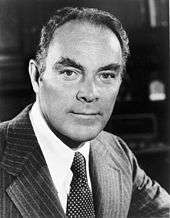

After only four months as VCSA, Haig returned to the Nixon administration at the height of the Watergate affair as White House chief of staff in May 1973. Retaining his Army commission, he remained in the position until September 21, 1974, ultimately overseeing the transition to the presidency of Gerald Ford following Nixon's resignation on August 9, 1974.
Haig has been largely credited with keeping the government running while President Nixon was preoccupied with Watergate[1] and was essentially seen as the "acting president" during Nixon's last few months in office.[15] During July and early August 1974, Haig played an instrumental role in finally persuading Nixon to resign. Haig presented several pardon options to Ford a few days before Nixon eventually resigned. In this regard, in his 1999 book Shadow, author Bob Woodward describes Haig's role as the point man between Nixon and Ford during the final days of Nixon's presidency. According to Bob Woodward, Haig played a major behind-the-scenes role in the delicate negotiations of the transfer of power from President Nixon to President Ford.[16] Indeed, about one month after taking office, Ford did pardon Nixon, resulting in much controversy.
Ford administration
Following the transition, Haig was replaced by Donald Rumsfeld. Author and Haig biographer Roger Morris, a former colleague of Haig's on the National Security Council early in Nixon's first term, wrote that when Ford pardoned Nixon, he in effect pardoned Haig as well.[17]
NATO Supreme Commander (1974–79)
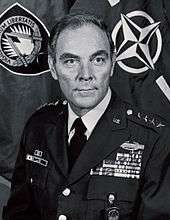
From 1974 to 1979 Haig served as the Supreme Allied Commander Europe, the commander of NATO forces in Europe, and commander in chief of United States European Command. Haig took the same route to SHAPE every day—a pattern of behavior that did not go unnoticed by terrorist groups. On June 25, 1979, Haig was the target of an assassination attempt in Mons, Belgium. A land mine blew up under the bridge on which Haig's car was traveling, narrowly missing Haig's car and wounding three of his bodyguards in a following car.[18] Authorities later attributed responsibility for the attack to the Red Army Faction (RAF). In 1993 a German court sentenced Rolf Clemens Wagner, a former RAF member, to life imprisonment for the assassination attempt.[18]
Civilian positions
Haig retired as a four-star general from the Army in 1979, and moved on to civilian employment. In 1979 he worked at the Philadelphia-based Foreign Policy Research Institute briefly and later served on that organization's board.[19] Later that year, he was named president and director of United Technologies Corporation under Chief Executive Officer Harry J. Gray, a job he retained until 1981.
Secretary of State (1981–82)
Haig was the second of three career military officers to become secretary of state (George C. Marshall and Colin Powell were the others). His speeches in this role in particular led to the coining of the neologism "Haigspeak," described in a dictionary of neologisms as "Language characterized by pompous obscurity resulting from redundancy, the semantically strained use of words, and verbosity,"[20] leading Ambassador Nicko Henderson to offer a prize for the best rendering of the Gettysburg address in Haigspeak.[21]
Initial challenges
On December 11, 1980, president-elect Reagan was prepared to publicly announce nearly all of his candidates for the most important cabinet-level posts. Singularly absent from the list of top nominees was his choice for Secretary of State, presumed by many at the time to be Al Haig. Haig's prospects for Senate confirmation were clouded when Senate Democrats questioned his role in the Watergate scandal. In Haig's defense, North Carolina Senator Jesse Helms claimed to have phoned former President Nixon personally to inquire whether any material on Nixon's unreleased White House tapes could embarrass Haig. According to Helms, Nixon replied, "Not a thing."[22] Haig was eventually confirmed after hearings he described as an "ordeal," during which he received no encouragement from Reagan or his staff.[23]
Several days earlier, on December 2, 1980, as Haig faced these initial challenges to the next step in his political career, four American Catholic missionary women in El Salvador, two of whom were Maryknoll sisters, were beaten, raped, and murdered by five Salvadoran national guardsmen ordered to surveil them. Their bodies were exhumed from a remote shallow grave two days later in the presence of then–U.S. ambassador to El Salvador Robert White. Despite this diplomatically awkward atrocity, the Carter administration soon approved $5.9 million in lethal military assistance to El Salvador's oppressive right-wing regime,[24] a figure the incoming Reagan administration expanded to $25 million less than six weeks later.[25] In justifying these arms shipments, the administration claimed that the regime had taken "positive steps" to investigate the murder of four American nuns, but this was disputed by US Ambassador, Robert E. White, who said that he could find no evidence the junta was "conducting a serious investigation." [72] White was dismissed from the foreign service by the Reagan Administration after he had refused to participate in a coverup of the Salvadoran military's responsibility for the murders at the behest of Secretary of State Alexander Haig.[26]
Throughout the 1980 U.S. presidential campaign, Reagan and his foreign policy advisers faulted the Carter administration's perceived over-emphasis on the human rights abuses committed by "authoritarian" regimes allied to the U.S., labeling it a "double standard" when compared with Carter's treatment of communist-bloc regimes. Haig, who described himself as the "vicar" of U.S. foreign policy,[27] believed the human rights violations of an American ally such as El Salvador should be given less attention than the ally's successes against American enemies, and thus found himself downplaying the nun killings before the House Foreign Affairs Committee in March 1981:
I'd like to suggest to you that some of the investigations would lead one to believe that perhaps the vehicle the nuns were riding in may have tried to run through a roadblock, or may have accidentally been perceived to have been doing so, and there may have been an exchange of fire, and then perhaps those who inflicted the casualties sought to cover it up.
— Alexander Haig, Alexander Haig, House Foreign Affairs committee testimony, quoted by UPI, March 19, 1981[28]
The outcry that immediately followed Haig's insinuation prompted him to emphatically withdraw his speculative suggestions the very next day before the Senate Foreign Relations Committee.[29] Similar public relations miscalculations, by Haig and others, continued to plague the Reagan administration's attempts to build popular American approval for its Central American policies.
Reagan assassination attempt: 'I am in control here'

In 1981, following the March 30 assassination attempt on Reagan, Haig asserted before reporters, "I am in control here"[30] as a result of Reagan's hospitalization, indicating that, while President Reagan had not "transfer[red] the helm," Haig was in fact directing White House crisis management until Vice President Bush arrived in Washington to assume that role.
Constitutionally, gentlemen, you have the president, the vice president, and the secretary of state in that order, and should the president decide he wants to transfer the helm to the vice president, he will do so. He has not done that. As of now, I am in control here, in the White House, pending return of the vice president and in close touch with him. If something came up, I would check with him, of course.
The U.S. Constitution, including both the presidential line of succession and the 25th Amendment, dictates what happens when a president is incapacitated. The Speaker of the House (at the time, Tip O'Neill, Democrat) and the president pro tempore of the Senate (at the time, Strom Thurmond, Republican), precede the secretary of state in the line of succession. Haig later clarified,
I wasn't talking about transition. I was talking about the executive branch, who is running the government. That was the question asked. It was not, "Who is in line should the president die?"
Falklands War
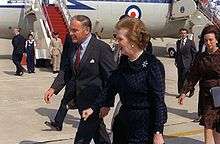
In April 1982 Haig conducted shuttle diplomacy between the governments of Argentina in Buenos Aires and the United Kingdom in London after Argentina invaded the Falkland Islands. Negotiations broke down and Haig returned to Washington on April 19. The British fleet then entered the war zone. In December 2012 documents released under the United Kingdom's 30 Year Rule disclosed that Haig planned to reveal British classified military information to Argentina in advance of the recapture of South Georgia Island. The information, which contained the United Kingdom's plans for the retaking of the island, was intended to show the Argentine military junta in Buenos Aires that the United States was a neutral player and could be trusted to act impartially during negotiations to end the conflict.[32] However, in 2012 it was revealed via declassified files from the Reagan Presidential Library that Haig manoeuvred to persuade Reagan to side with Argentina.[33]
1982 Lebanon War
Haig's report to Reagan on January 30, 1982, shows that Haig feared that the Israelis might start a war against Lebanon.[34] Critics accused Haig of "greenlighting" the Israeli invasion of Lebanon in June 1982. Haig denied this and said he urged restraint.[35]
Resignation
Haig caused some alarm with his suggestion that a "nuclear warning shot" in Europe might be effective in deterring the Soviet Union.[36] His tenure as secretary of state was often characterized by his clashes with the defense secretary, Caspar Weinberger. Haig, who repeatedly had difficulty with various members of the Reagan administration during his year-and-a-half in office, decided to resign his post on June 25, 1982.[37] President Reagan accepted his resignation on July 5.[38] Haig was succeeded by George P. Shultz, who was confirmed on July 16.[39]
1988 Republican presidential primaries
Haig ran unsuccessfully for the 1988 Republican Party presidential nomination. Although he enjoyed relatively high name recognition, Haig never broke out of single digits in national public opinion polls. He was a fierce critic of then–Vice President George H.W. Bush, often doubting Bush's leadership abilities, questioning his role in the Iran–Contra affair, and using the word "wimp" in relation to Bush in an October 1987 debate in Texas.[40] Despite extensive personal campaigning and paid advertising in New Hampshire, Haig remained stuck in last place in the polls. After finishing with less than 1 percent of the vote in the Iowa caucuses and trailing badly in the New Hampshire primary polls, Haig withdrew his candidacy and endorsed Senator Bob Dole.[41][42] Dole, steadily gaining on Bush after beating him handily a week earlier in the Iowa caucus, ended up losing to Bush in the New Hampshire primary by 10 percentage points. With his momentum regained, Bush easily won the nomination.
In popular culture
In the 1982 Police Squad! episode "Testimony of Evil (Dead Men Don't Laugh)," Detectives Drebin and Hocken are looking at a small photograph of Alexander Haig on a slab in a morgue where Drebin states: "This is disgusting!" and Hocken states: "Yeah, I can't take looking at that sort of thing."
In the 1982 film Airplane II: The Sequel, the bomber, Joe Seluchi (Sonny Bono), is briefly seen reading a magazine titled Psycho of the Month with Haig on the front cover.
In Part 2 of The Simpsons episode "Who Shot Mr. Burns?," a mug shot of a battered and bruised Homer Simpson is shown, in which he is wearing a T-shirt with the campaign slogan "Haig in '88" on it.
In the 1986 Sledge Hammer! episode "Over My Dead Bodyguard", Captain Trunk is announced dead after several failed assassinations to prevent further attempts. Sledge Hammer then declares in a takeover ceremony in the precinct "But, in the words of the immortal Alexander Haig: 'As of now, I am in control.'"
Haig was played by David Ogden Stiers in the 1989 TV film The Final Days, by Powers Boothe in the 1995 film Nixon, by Matt Frewer in the 1995 TV miniseries Kissinger And Nixon, by Richard Dreyfuss in the 2001 cable film The Day Reagan Was Shot, by Bill Smitrovich in the 2003 TV movie The Reagans, by Colin Stinton in the 2002 The Falklands Play, by Matthew Marsh in the 2011 film The Iron Lady, and by Patrick St. Esprit in the 2016 television film Killing Reagan.
Haig was also mentioned in the last level of Interstate '82, where Ronald Reagan claims that Haig was pressured to resign from office by the president himself.
Haig is mentioned in the Dead Kennedys song "We've Got a Bigger Problem Now", which was critical of Reagan's presidency.
In the fourth episode of the first season of The Americans, Haig's remark that he was "in control" after the attempted assassination attempt on Ronald Reagan is treated by the Soviets as indicative of a potential coup in the U.S. government.
Later life, health, and death
In 1980 Haig had a double heart bypass operation.[43] In the 1980s and '90s, being the head of a consulting firm, he served as a director for various struggling businesses, the best-known probably being computer manufacturer Commodore International.[44] He also served as a founding corporate director of America Online.[45]
Haig was the host for several years of the television program World Business Review. At the time of his death, he was the host of 21st Century Business, with each program a weekly business education forum that included business solutions, expert interview, commentary, and field reports.[46] Haig served as a founding member of the advisory board of Newsmax Media, which publishes the conservative web site, Newsmax.com.[47] Haig was co-chairman of the American Committee for Peace in the Caucasus, along with Zbigniew Brzezinski and Stephen J. Solarz. A member of the Washington Institute for Near East Policy (WINEP) board of advisers, Haig was also a founding board member of America Online.[48]
On January 5, 2006, Haig participated in a meeting at the White House of former secretaries of defense and state to discuss U.S. foreign policy with Bush administration officials.[49] On May 12, 2006, Haig participated in a second White House meeting with 10 former secretaries of state and defense. The meeting included briefings by Donald Rumsfeld and Condoleezza Rice and was followed by a discussion with President George W. Bush.[50] Haig's memoirs—Inner Circles: How America Changed The World—were published in 1992.
On February 19, 2010, a hospital spokesman revealed that the 85-year-old Haig had been hospitalized at Johns Hopkins Hospital in Baltimore since January 28 and remained in critical condition.[51] On February 20, Haig died at the age of 85, from complications from a staphylococcal infection that he had prior to admission. According to The New York Times, his brother, Frank Haig, said the Army was coordinating a mass at Fort Myer in Washington and an interment at Arlington National Cemetery, but both had to be delayed by about two weeks owing to the wars in Afghanistan and Iraq.[15] A Mass of Christian Burial was held at the Basilica of the National Shrine of the Immaculate Conception in Washington, D.C., on March 2, 2010. Eulogies were given by Henry Kissinger and Sherwood D. Goldberg.[52]
President Barack Obama said in a statement that "General Haig exemplified our finest warrior–diplomat tradition of those who dedicate their lives to public service."[53] Secretary of State Hillary Clinton described Haig as a man who "served his country in many capacities for many years, earning honor on the battlefield, the confidence of presidents and prime ministers, and the thanks of a grateful nation."[54]
Family
Alexander Haig was married to Patricia (née Fox), with whom he had three children: Alexander Patrick Haig, Barbara Haig, and Brian Haig.[55] Haig's younger brother, Frank Haig, is a Jesuit priest and professor emeritus of physics at Loyola University in Baltimore, Maryland.[56] Alexander Haig's sister, Regina Meredith, was a practicing attorney licensed in Pennsylvania and New Jersey, and was a co-founding partner of the firm Meredith, Chase and Taggart, located in Princeton and Trenton, New Jersey. She died in 2008.
Publications
Articles
- “Introduction”. World Affairs, Vol. 144, No. 4, Statements by Ambassador Max Kampelman before the Madrid Conference on Security and Cooperation in Europe, Spring 1982. JSTOR 20671913 (pp. 299-301)
- “Stalemate: The Public Reaction to Poland“. World Affairs, Vol. 144, No. 4, Statements by Ambassador Max Kampelman before the Madrid Conference on Security and Cooperation in Europe, Spring 1982. JSTOR 20671920 (pp. 467-511)
- “U.S. Foreign Policy: A Discussion with Former Secretaries of State Dean Rusk, William P. Rogers, Cyrus R. Vance, and Alexander M. Haig, Jr.”. International Studies Notes, Vol. 11, No. 1, Special Edition: The Secretaries of State, Fall 1984. JSTOR 44234902 (pp. 10-20)
- ”Reply”. Journal of Interamerican Studies and World Affairs, Vol. 27, No. 2, Summer 1985. doi:10.2307/165716 JSTOR 165716 (pp. 23-24)
- ”The Challenges to American Leadership”. Harvard International Review, Vol. 11, No. 3, Tenth Anniversary Issue – American Foreign Policy: Toward the 1990s, 1989. JSTOR 43648931 (pp. 24-29)
- ”Nation Building: A Flawed Approach”. The Brown Journal of World Affairs, Vol. 2, No. 1, Winter 1994. JSTOR 24595446 (pp. 7-10)
Books
- Caveat: Realism, Reagan and Foreign Affairs. New York, NY: Macmillan Publishing Company, 1984. ISBN 978-0025473706. 367 pages.
- Inner Circles: How America Changed the World: A Memoir. New York, NY: Warner Books, 1992. ISBN 978-0446515719 LCCN 91-50409. 650 pages.
Contributed works
- “Foreword”. Soviet Leaders from Lenin to Gorbachev by Thomas Streissguth. Minneapolis, MN: Oliver Press, 1992. ISBN 978-1881508021 LCCN 92-19903 (pp. 7-8)
Awards and decorations
Haig's awards and decorations include:
 | ||
| Valorous Unit Award | ||
| Republic of Korea Presidential Unit Citation | Republic of Vietnam Gallantry Cross Unit Citation | Republic of Vietnam Civil Actions Medal Unit Citation |
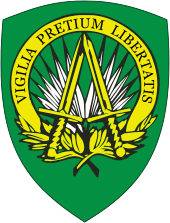 | ||
| SHAPE Badge | ||
References
- "Alexander Haig". MSN Encarta. Archived from the original on March 10, 2008.
- "Premier Speakers Bureau". Archived from the original on January 14, 2010.
- Hohmann, James (February 21, 2010). "Alexander Haig, 85; soldier-statesman managed Nixon resignation". The Washington Post. Archived from the original on June 4, 2011. Retrieved February 21, 2010.
- "Haig's Future Uncertain After a Shaky Start". Anchorage Daily News. April 11, 1981. Retrieved December 22, 2009.
- Bellow, Adam (July 13, 2004). In Praise of Nepotism. ISBN 9781400079025.
- Weiner, Tim (February 20, 2010). "Alexander M. Haig Jr. Dies at 85; Was Forceful Aide to 2 Presidents". The New York Times.
- Jackson, Harold (February 20, 2010). "Alexander Haig obituary". The Guardian.
- "Al Haig, the long goodbye".
- Alexander M. Haig, Jr. "Lessons of the forgotten war".
- "UT Biography". Archived from the original on May 11, 2013.
- Weiner, Tim (February 20, 2010). "Alexander M. Haig Jr. Dies at 85; Was Forceful Aide to 2 Presidents". The New York Times. Retrieved January 9, 2017.
- "West Point Citation". Archived from the original on May 16, 2006.
- "Full Text Citations For Award of The Distinguished Service Cross, US Army Recipients – Vietnam".
- "4‐Star Diplomat in White House Alexander Meigs Haig Jr". The New York Times. May 5, 1973.
- Weiner, Tim (February 20, 2010). "Alexander M. Haig Jr., 85, Forceful Aide to 2 Presidents, Dies". The New York Times. Archived from the original on February 23, 2010. Retrieved February 20, 2010.
- The Final Days, by Bob Woodward and Carl Bernstein, 1976, New York, Simon & Schuster; Shadow, by Bob Woodward, 1999, New York, Simon & Schuster, pp. 4–38.
- Haig: The General's Progress, by Roger Morris (American writer), Playboy Press, 1982, pp. 320–25.
- "German Guilty in '79 Attack At NATO on Alexander Haig". The New York Times. November 25, 1993.
- Maykuth, Andrew (February 21, 2010). "Philadelphia dominated Haig's formative years". Philadelphia Inquirer.
- Fifty years among the new words: a dictionary of neologisms, 1941–1991, John Algeo, p.231
- Financial Times, London, March 21, 2009
- "Reagan selects half of Cabinet-level staff". Gadsden Times. Associated Press. December 11, 1980.
- Chace, James (April 22, 1984). "The Turbulent Tenure of Alexander Haig". The New York Times.
- LeoGrande, William (1998). Our Own Backyard: The United States in Central America, 1977–1992. Chapel Hill: University of North Carolina Press. p. 70. ISBN 0807898805.
- LeoGrande 1998, p. 89.
- Bonner, Raymond (November 9, 2014). "Bringing El Salvador Nun Killers to Justice". The Daily Beast. Retrieved January 16, 2018.
- "Alexander Haig". The Economist. February 25, 2010.
- "Church Women Ran Roadblock, Haig Theorizes". Pittsburgh Press. UPI. March 19, 1981. Retrieved December 8, 2013.
- Michaels, Leonard; Ricks, Christopher (1990). The State of the Language (2nd ed.). Berkeley: University of California Press. p. 261. ISBN 0520059069.
- Michael Goodwin | New York Post, The 'anonymous official op-ed' is less than it seems, https://nypost.com/2018/09/06/the-anonymous-official-op-ed-is-less-than-it-seems/, September 6, 2018
- "Alexander Haig". Time. April 2, 1984. p. 22 of 24 page article. Archived from the original on April 6, 2008. Retrieved May 21, 2008.
- Tweedie, Neil (December 28, 2012). "US wanted to warn Argentina about South Georgia". Telegraph. Retrieved June 4, 2014.
- O'Sullivan, John (April 2, 2012). "How the U.S. Almost Betrayed Britain". Washington Post. Retrieved December 6, 2019.
- Ronald Reagan edited by Douglas Brinkley (2007) The Reagan Diaries Harper Collins ISBN 978-0-06-087600-5 p. 66 Saturday, January 30
- "Alexander Haig". Time. April 9, 1984.
- Waller, Douglas C. Congress and the Nuclear Freeze: An Inside Look at the Politics of a Mass Movement, 1987. Page 19.
- 1982 Year in Review: Alexander Haig Resigns
- Ajemian, Robert; George J. Church; Douglas Brew (July 5, 1982). "The Shakeup at State". Time. Archived from the original on March 27, 2010. Retrieved February 21, 2010.
- Short History of the Department of State, United States Department of State, Office of the Historian. Retrieved February 20, 2010.
- Dowd, Maureen (November 21, 1987). "Haig, the Old Warrior, in New Battles". The New York Times. Retrieved May 26, 2015.
- "Haig Calls Meeting to Discuss Campaign". Los Angeles Times. Associated Press. February 12, 1988. Retrieved May 26, 2015.
- Clifford, Frank (February 13, 1988). "Haig Drops Out of GOP Race, Endorses Dole". Los Angeles Times. Retrieved May 26, 2015.
- Harold Jackson (February 20, 2010). "obituary". The Guardian. Retrieved June 4, 2014.
- "Businessweek June 16, 1991". Businessweek.com. June 16, 1991. Retrieved June 4, 2014.
- "New Atlanticist". Acus.org. Archived from the original on April 30, 2013. Retrieved June 4, 2014.
- "World Business Review with Alexander Haig". Archived from the original on October 25, 2006. Retrieved December 17, 2008.
- General Alexander M. Haig, Jr. joins Newsmax.com advisory board, "PR Newswire", June 21, 2001.
- "Business Wire AOL-TIme Warner announces its board of directors". Business Wire. January 12, 2001. Archived from the original on July 8, 2012. Retrieved December 17, 2008.
- "President George W. Bush poses for a photo Thursday, January 5, 2006, in the Oval Office with former secretaries of state and secretaries of defense from both Republican and Democratic administrations, following a meeting on the strategy for victory in Iraq". The White House. January 5, 2006. Retrieved December 17, 2008.
- "Bush discusses Iraq with former officials".
- "Haig, top adviser to 3 presidents, hospitalized". Associated Press. February 19, 2010. Archived from the original on March 27, 2019. Retrieved February 20, 2010.
- "Alexander M. Haig, Jr". West Point Association of Graduates. Archived from the original on March 20, 2012. Retrieved August 9, 2011.
- "Alexander M. Haig Jr. Dies at 85; Was Forceful Aide to 2 Presidents". The New York Times. February 20, 2010.
- "Alexander Haig, former secretary of state, dies at 85". Washington Times. February 20, 2010. Retrieved June 4, 2014.
- Alexander M. Haig Jr., 85, forceful aide to 2 Presidents, dies
- Krebs, Albin (January 25, 1982). "NOTES ON PEOPLE; A Haig Inaugurated". New York Times. Retrieved February 25, 2010.
- "Cidadãos Estrangeiros Agraciados com Ordens Portuguesas". Página Oficial das Ordens Honoríficas Portuguesas. Retrieved August 1, 2017.
Further reading
- Colodny, Len and Robert Gettlin. Silent Coup: The Removal of a President. New York: St. Martin's Press, 1991.
- Haig, Alexander. Caveat: Realism, Reagan and Foreign Affairs. New York: Macmillan Publishing Company, 1984.
- Haig, Alexander and Charles McCarrry. Inner Circles: How America Changed the World. Grand Central Publishing, 2 January 1994.
- Hersh, Seymour. The Price of Power: Kissinger in the Nixon White House. New York: Summit Books, 1983. ISBN 0-671-50688-9
- Morris, Robert. Haig: The General’s Progress. ISBN 0872237532 LCCN 81-82835. 490 pages.
External links
| Wikimedia Commons has media related to Alexander Haig. |
| Wikiquote has quotations related to: Alexander Haig |
- The Day Reagan was Shot article on Haig
- The Falklands: Failure of a Mission critique of Haig's mediation efforts
- Portrait of Alexander Haig by Margaret Holland Sargent
- Appearances on C-SPAN
- Alexander Haig on IMDb
- Alexander Meigs Haig Jr at Find a Grave
| Political offices | ||
|---|---|---|
| Preceded by Richard V. Allen |
Deputy National Security Advisor 1970–1973 |
Succeeded by Brent Scowcroft |
| Preceded by H. R. Haldeman |
White House Chief of Staff 1973–1974 |
Succeeded by Donald Rumsfeld |
| Preceded by Edmund Muskie |
United States Secretary of State 1981–1982 |
Succeeded by George P. Shultz |
| Military offices | ||
| Preceded by Bruce Palmer Jr. |
Vice Chief of Staff of the Army 1973 |
Succeeded by Frederick C. Weyand |
| Preceded by Andrew Goodpaster |
Supreme Allied Commander Europe 1974–1979 |
Succeeded by Bernard W. Rogers |
.jpg)

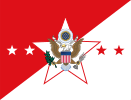
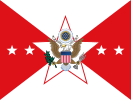



.jpg)